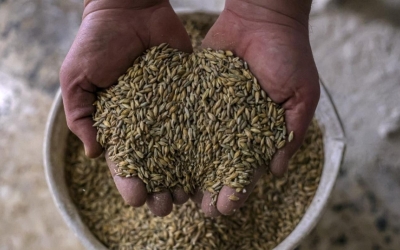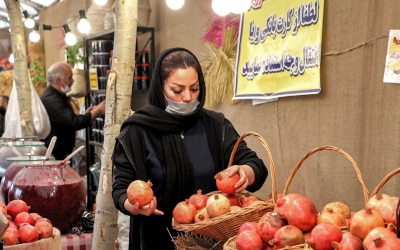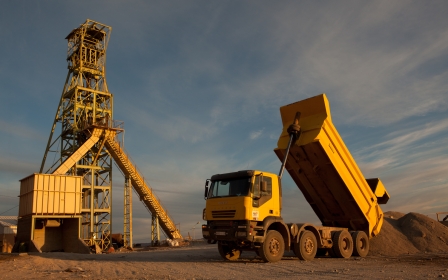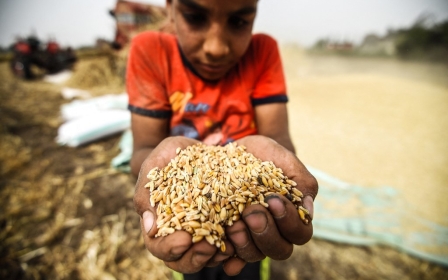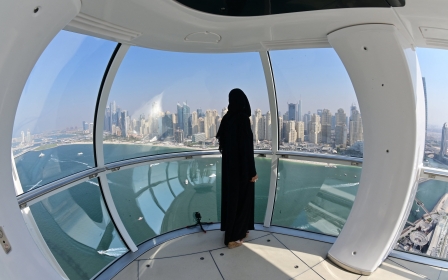Profits soar at Middle East fertiliser companies amid Ukraine war

Fertiliser companies and miners in the Middle East have chalked up record profits and ramped up production this year amid a global rally in commodities.
The Middle East is perhaps better known for deserts than fertile fields and is itself a major importer of foodstuffs, but it is also nutrient-rich, and the rising fortunes of the region's fertiliser sector underscore some of the tectonic shifts rippling through the global economy.
Last year, the Middle East exported 19 percent of the world's phosphate; 35 percent of urea; 19 percent of ammonia nitrogen; and 10 percent of potash. North Africa was also a crucial supplier of global phosphates - 25 percent, as well as nitrogen compounds These three elements, "NPK" comprise fertiliser.
Fertiliser prices more than doubled last year as pandemic lockdowns eased and the industry struggled with supply chain disruptions. A series of factors propelled the rally: storms dented US production; China banned the export of phosphates; and rising natural gas prices, a key component of nitrogen-based fertilisers, led to plant shutdowns in Europe.
The war in Ukraine has added new momentum to the rally, with supply from Russia, the world's largest exporter of fertilisers, choked by western sanctions and fighting.
Despite carve-outs to US sanctions permitting the purchase of fertilisers, many buyers have stayed away from Russia for fear of violating other restrictions. The Kremlin has also sent shudders through the market by threatening to cut off shipments.
"The Middle East is in a sweet spot with these supply shocks, and has a good opportunity to improve its reliability as a supplier to key markets," Chris Lawson, head of fertilisers at CRU, a commodity analysis firm, told Middle East Eye.
Industry leaders and government officials have taken note. Last week, Brazil's agriculture minister began a whirlwind trip to Jordan, Egypt and Morocco for what he said was, "a pilgrimage that we are calling fertiliser diplomacy".
The run-up in prices is particularly concerning for Brazil, an agricultural powerhouse and the world's largest importer of fertilisers.
The South American country is heavily reliant on Russia for nutrients and has seen supply curtailed. In April, Russia exported just 300,000 tons of fertiliser to Brazil, down by roughly half the amount it normally ships at this time of year, according to preliminary data shared with MEE by StoneX, a financial service firm.
Less fertiliser means lower crop yields, and the shortfall in supplies has prompted warnings about a potential global food crisis - and the Middle East would certainly not be immune. Countries from Egypt to Tunisia are already reeling from sky-high wheat prices, exacerbated by the war in Ukraine.
Still, the geopolitical tensions and supply chain bottlenecks have been a boon to some.
"The past year has been excellent for fertiliser companies, including those in the Middle East," Saad El-Maati, former chairman & managing director of Abu Qir Fertilizers, Egypt's largest producer of nitrogen fertilizer, told MEE.
"Conditions for Egypt are especially promising because we have fantastic logistics and cheaper energy costs relative to Europe, where spot prices are higher," he added.
Rising prices have lifted company profits. Abu Qir reported a gain of $376m in the first quarter of this year ending 31 March, compared to $131m in the same period last year.
It's a trend widespread across the region. The Saudi Arabian Mining Company (Ma'aden) reported a record net profit of $772.2m for its first quarter, up 246 percent from the same period last year. Morocco's state-owned fertiliser producer OCP saw 2021 profits surge 272 percent from the year before, while at Jordan Phosphate Mines the gains skyrocketed more 1,000 percent.
Besides phosphates, the otherwise resource-poor Hashemite Kingdom of Jordan lays claim to being the only Arab producer of potash. According to data from CRU, Jordan exported about four percent of the world's potash in 2021, making it the 6th-largest global supplier.
Jordan is a small player in the market compared to Russia and Belarus, which together account for 40 percent of the world's exports. But Belarus's potash industry was sanctioned last year after Minsk targeted a government opponent. More sanctions were applied to the country and its ally Russia after the latter’s invasion of Ukraine.
"Business really started picking up when Belarus was put under sanction," Maen Nsour, president and CEO of Jordan's Arab Potash Company (APC), told MEE.
"While no one wants to see a war, the current conflict between Russia and Ukraine has only added to the momentum we are seeing," he said.
Potash prices, already at all-time highs before the war, rallied 50 percent after the Russian invasion. And buyers in Europe looked to APC to fill supply gaps. In the first quarter of this year, the company reported a roughly 260 percent increase in net income.
Nsour is confident the record numbers will continue and says the company is expanding outside of its traditional markets in Asia, to the US, Australia and Brazil, where APC plans to open an office.
The company has also invested in a new compactor to increase the granularity of its stock and is working on a plant expansion, as it plans to increase production of its red granular potash from 0.5 million tons to 1.2 million by 2023.
"We are serious about filling the shortfalls in the market with the adequate quantities we can provide," Nsour said.
Luigi Bezzon, a StoneX analyst based in Brazil, said farmers there would welcome the additional volumes, but cautioned that their impact would be limited.
"The output increases are a help, but it’s going to be hard for second-class producers to meet the supply shortages coming from big countries like Russia and Belarus," he told MEE.
The Middle East is more competitive in phosphate and nitrogen, where Alzbeta Klein, CEO and director general of the International Fertilizer Association, told MEE the region "represent[s] a steady and well-located source of volumes for destination markets both the east and west of Suez".
Morocco is home to 72 percent of global phosphate reserves and is the world's fourth-largest exporter of fertilisers. State-owned OCP announced in March that it aimed to raise fertiliser output by more than 10 percent in 2022.
New projects are also coming online in the Gulf. Oman is set to open a new ammonium plant this year, while Saudi Arabia hopes to see years of heavy investments it made into the mining and fertiliser industry as part of its transition away from petrodollars, bare fruit. Ma’aden also plans to start production at a new ammonium plant in 2022.
"Increased capacity is coming in at exactly the right time," said Lawson, at the commodity analysis firm CRU. "The world desperately needs that ammonia."
At the same time, the Gulf states' ambitions in nitrogen-based fertiliser have long been aided by their access to cheap natural gas, a necessary component for the nutrient's production. And while Russia was the world’s largest nitrogen exporter in 2021, the industry is more diverse than that of other fertilizer components.
Qatar, Egypt and Saudi Arabia are among the top five producers globally for the urea form of nitrogen fertilisers, and together, made about 29 percent of global exports last year. Russia accounted for 14 percent.
Analysts say Middle Eastern countries in this sector of the industry are likely the ones best positioned to fill supply gaps left by Russia.
"The biggest thing the Middle East can actually move the dial on in terms of fertilisers is nitrogen, the region is a huge producer and that is where there are opportunities," Lawson said.
Middle East Eye propose une couverture et une analyse indépendantes et incomparables du Moyen-Orient, de l’Afrique du Nord et d’autres régions du monde. Pour en savoir plus sur la reprise de ce contenu et les frais qui s’appliquent, veuillez remplir ce formulaire [en anglais]. Pour en savoir plus sur MEE, cliquez ici [en anglais].


